
The 32X is an add-on for the Sega Genesis video game console. Codenamed "Project Mars", it was designed to expand the power of the Genesis and serve as a transitional console into the 32-bit era until the release of the Sega Saturn. The 32X uses its own ROM cartridges and has its own library of games. It was distributed under the name Super 32X in Japan and South Korea, Genesis 32X in North America, Mega 32X in Brazil, and Mega Drive 32X in all other regions.

The Sega Saturn is a home video game console developed by Sega and released on November 22, 1994, in Japan, May 11, 1995, in North America, and July 8, 1995, in Europe. Part of the fifth generation of video game consoles, it is the successor to the successful Genesis. The Saturn has a dual-CPU architecture and eight processors. Its games are in CD-ROM format, including several ports of arcade games and original games.

Virtua Fighter is a fighting game created for the Sega Model 1 arcade platform by AM2, a development group within Sega, headed by Yu Suzuki. An early prototype version was location tested in Japan by August 1993, before the complete game was released worldwide in December 1993. It is the first game in the Virtua Fighter series, and the first arcade fighting game to feature fully 3D polygon graphics. The game has been ported to several platforms including the Sega Saturn, Sega 32X, and Microsoft Windows.

NBA Jam is a basketball video game developed and published by Midway for arcades in 1993. It is the first entry in the NBA Jam series. The project leader for this game was Mark Turmell.

Virtua Cop is a 1994 light gun shooter game developed by Sega AM2 and designed by Yu Suzuki. It was originally an arcade game on the Sega Model 2 system, and was ported to the Sega Saturn in 1995 and Windows in 1996. The Saturn version included support for both the Virtua Gun and Saturn mouse, as well as a new "Training Mode" which consists of a randomly generated shooting gallery.

Daytona USA is an arcade racing game developed by Sega AM2 and released by Sega in March of 1994. Inspired by the popularity of the NASCAR motor racing series in the US, the game has players race stock cars on one of three courses. It was the first game to be released on the Sega Model 2 arcade system board. Daytona USA is one of the highest-grossing arcade games of all time.
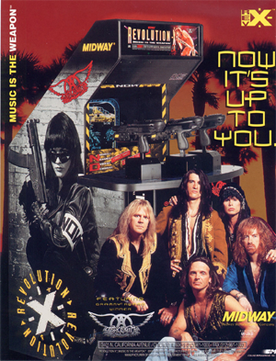
Revolution X is a shooting gallery video game developed by Midway and released in arcades in 1994. The gameplay is similar to Midway's earlier Terminator 2: Judgment Day, but is themed around the band Aerosmith. The oppressive New Order Nation regime and their leader Helga have abducted Aerosmith, and players use a mounted gun to control onscreen crosshairs and shoot enemies. The members of Aerosmith are hidden throughout the game's international locales and must be found in order to receive the game's true ending.

Virtua Racing or V.R. for short, is a Formula One racing video game developed by Sega AM2 and released for arcades in 1992. Virtua Racing was initially a proof-of-concept application for exercising a new 3D graphics platform under development, the "Model 1". The results were so encouraging that Virtua Racing was fully developed into a standalone arcade title.

Primal Rage is a fighting game developed and released by Atari Games for arcades in 1994. The game takes place on a post-apocalyptic version of Earth called "Urth". Players control one of seven prehistoric beasts, that battle each other to determine the planet's fate. Matches feature many of the conventions of fighting games from the era, including special moves and gory finishing maneuvers. Ports were released for home video game consoles and personal computers. Efforts to perfectly emulate the arcade original have been unsuccessful due to the use of an unusual copy protection method. Toys, comics, a novel and other merchandise tie-ins were produced. More than 1.5 million copies of the game were sold.
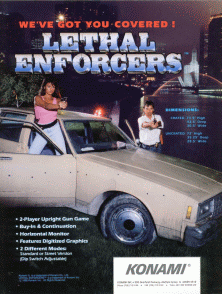
Lethal Enforcers is a 1992 light gun shooter released as an arcade video game by Konami. The graphics consist entirely of digitized photographs and digitized sprites. Home versions were released for the Super NES, Genesis and Sega CD during the following year and include a revolver-shaped light gun known as The Justifier.

Virtua Fighter 2 is a 1994 fighting video game developed by Sega. It is the sequel to Virtua Fighter (1993), and the second game in the Virtua Fighter series. It was created by Sega's Yu Suzuki-headed AM2 and was released for arcades in 1994. Ports were released for the Sega Saturn in 1995 and Microsoft Windows in 1997.

Tomcat Alley is an interactive movie FMV video game developed by The Code Monkeys for Sega CD. It was the first Sega CD game to feature extensive full screen, full motion video. It was later released, with higher quality video, for Windows-based PCs. A 32X version was also in development, but never released.

Corpse Killer is a horror-themed rail shooter developed and published by Digital Pictures for the Sega CD, Sega CD 32X, 3DO, Sega Saturn, Windows 95 and Macintosh computers. An interactive variation on the zombie film genre, it utilizes live-action full motion video in a format similar to other games developed by Digital Pictures. Reviews for the game were mixed, generally criticizing the repetitive gameplay and low video quality, though many reviewers enjoyed the campy nature of the cutscenes. Corpse Killer was the first CD game released for the Sega 32X. It was later remastered for Steam, PlayStation 4 and Nintendo Switch.
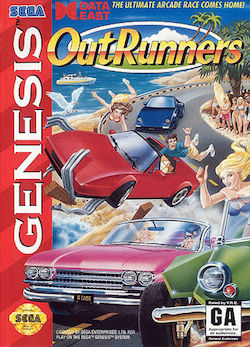
OutRunners is a racing video game developed by Sega AM1 and released in Japan, Europe, and North America in 1993. It constitutes the third release in the arcade OutRun series and was ported to the Mega Drive in 1994.
Jurassic Park is a rail shooter arcade game developed and released by Sega in 1994. It is based on the 1993 film of the same name. The game cabinet resembles the rear of the first-gen Ford Explorer XLT tour vehicles used in the film. The player(s), equipped with the joystick(s), must shoot dinosaurs that appear on-screen throughout the game.
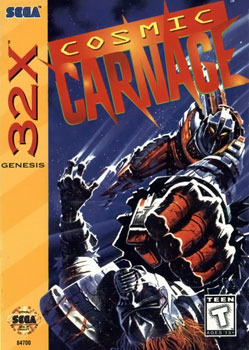
Cosmic Carnage is a 1994 fighting video game developed by Almanic Corporation, in conjunction with ALU, and published by Sega exclusively for the 32X add-on. Set in an uncharted star system, the game follows eight fighters from two factions in a struggle for survival. Its gameplay consists of one-on-one fights, with a main six-button configuration, featuring special moves and finisher techniques, as well as two playable modes. The title garnered mostly negative reception from critics since its release.
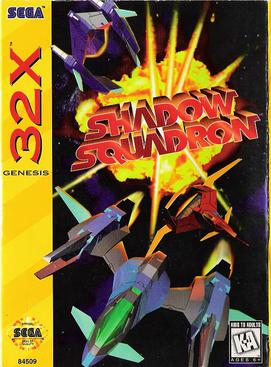
Shadow Squadron is a space combat simulation video game developed and published by Sega exclusively for the 32X add-on first in Japan on 26 April 1995, then in North America and Europe in June of the same year.

Wing War is a 1994 combat flight simulator game developed for the Sega Model 1 arcade platform by Sega. the object of the game is by where the players fight head-to-head in airplanes trying to shoot the other players out of the sky. Running on the same hardware as Sega's Virtua Fighter and Virtua Racing, the game features 3D polygon graphics.

Metal Head is a first-person shooter mech simulation video game developed and published by Sega, and released in 1995 for the Genesis/Mega Drive's 32X add-on, allowing for fully texture-mapped 3D polygons.

















